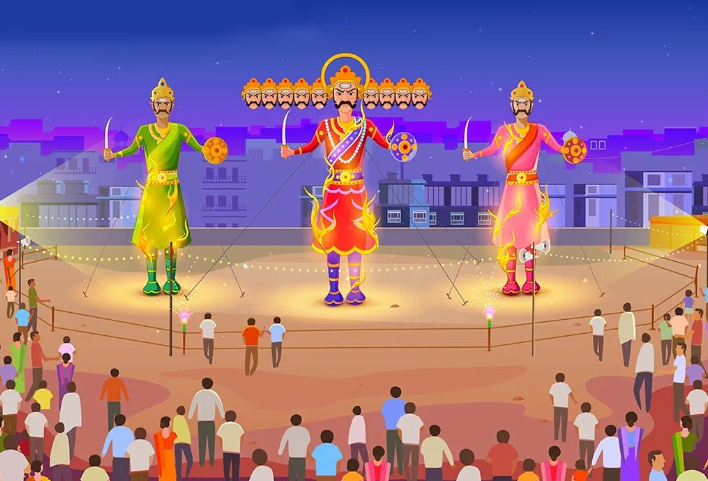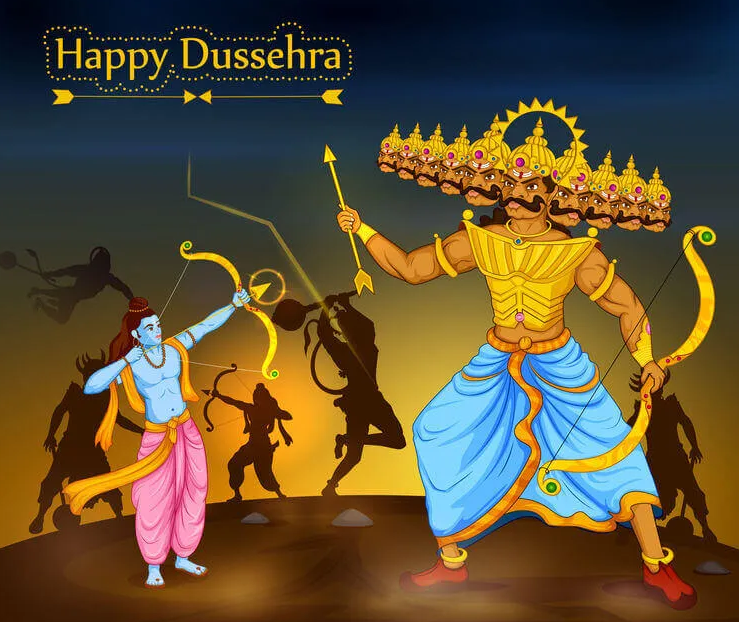Dashahara in Odisha, also known as Dussehra, is a grand festival celebrated with great zeal and enthusiasm in the state of Odisha, India. This vibrant occasion marks the triumph of good over evil and commemorates the victory of Lord Rama over the demon king Ravana, as described in the ancient epic Ramayana. Dashahara holds immense cultural and religious significance for the people of Odisha, bringing communities together in joyous celebration.
Dashahara is observed on the tenth day of the Hindu month of Ashwin (September-October). The festival spans nine nights preceding Dashami, which are collectively known as Navaratri. These nights are dedicated to the worship of various manifestations of the divine feminine energy, particularly Goddess Durga, who symbolizes strength, courage, and protection.

The preparations for Dashahara begin weeks in advance. Elaborate pandals (temporary structures) are constructed across cities, towns, and villages, where beautifully adorned idols of Goddess Durga are installed. Skilled artisans craft intricate sculptures depicting the goddess slaying the buffalo demon Mahishasura, representing the victory of good over evil.
The festival commences with the ritualistic invocation or Pran Pratistha of the goddess, where priests perform sacred rituals to infuse life into the idols. Devotees gather at the pandals, offering prayers and seeking the blessings of Goddess Durga. The atmosphere is filled with devotion, chants of mantras, and the fragrance of incense.
The highlight of Dashahara in Odisha is the extravagant display of traditional dance forms, especially the famous Durga Puja dance called “Durga Dance” or “Garba.” People, both young and old, dressed in vibrant traditional attire, participate in these rhythmic and energetic dances, paying homage to the goddess and celebrating her triumph over evil.
You can read our another post on Dance of Odisha

The festival also showcases various cultural programs, including music concerts, theatrical performances, and art exhibitions. These events provide a platform for talented artists to showcase their skills and entertain the audience with their artistic expressions. The streets come alive with processions, where beautifully decorated idols of Goddess Durga are taken on elaborately adorned chariots, accompanied by music and chanting of hymns.
On the final day of Dashahara, known as Vijaya Dashami, the idols are immersed in water bodies, symbolizing the departure of the goddess after her victorious stay on earth. This ritual, called Visarjan, is performed with great reverence and devotion. It signifies the fleeting nature of existence and emphasizes the transient nature of power and ego, ultimately surrendering everything to the divine.
Dashahara in Odisha is more than just a religious festival; it carries deep-rooted cultural and social significance. It brings communities together, fostering a sense of unity, harmony, and brotherhood among people from different backgrounds. The festival transcends barriers of caste, creed, and age, encouraging collective participation and celebration of shared values.
Dashahara serves as a reminder of the eternal battle between good and evil within each individual. It inspires devotees to strive for righteousness, truth, and justice in their lives. The festival instills the virtues of courage, determination, and perseverance, as exemplified by Lord Rama in his pursuit of righteousness.

Write A FAQ for Dashahara in Odisha
What is Dashahara?
Dashahara, also known as Dussehra, is a Hindu festival celebrated in Odisha and other parts of India. It marks the victory of good over evil and is a symbol of the triumph of Lord Rama over the demon king Ravana.
When is Dashahara celebrated in Odisha?
Dashahara is celebrated on the tenth day of the Hindu month of Ashvin, which usually falls in the month of September or October. The exact date varies each year according to the Hindu calendar.
How is Dashahara celebrated in Odisha?
In Odisha, Dashahara is celebrated with great enthusiasm. People decorate their homes, temples, and public places with lights and intricate designs known as Rangoli. The festival involves special prayers, cultural performances, and the burning of effigies of Ravana, Meghnad, and Kumbhakarna.
Are there any unique customs followed during Dashahara in Odisha?
Yes, a unique tradition followed in Odisha during Dashahara is the ‘Jhamu Yatra’, which involves a procession of men and women dressed in colorful attire and carrying different types of weapons. This procession symbolizes the victory of good over evil.
Do people exchange gifts during Dashahara in Odisha?
Yes, exchanging gifts is a common practice during Dashahara in Odisha. People give each other sweets, fruits, clothes, and other traditional items as a gesture of goodwill and love.
Are there any specific food items associated with Dashahara in Odisha?
Yes, people in Odisha indulge in various delicious food items during Dashahara. Some popular dishes include chhena poda (a sweet made from cottage cheese), pitha (rice cakes), khaja (a crispy sweet snack), and various traditional sweets and desserts.
Are there any fairs or melas organized during Dashahara in Odisha?
Yes, during Dashahara, many fairs or melas are organized across Odisha. These fairs feature various cultural performances, shopping stalls, food stalls, joy rides, and traditional games, providing entertainment for all age groups.
Are there any significant temples to visit during Dashahara in Odisha?
Odisha is known for its ancient and significant temples. During Dashahara, visiting temples dedicated to Lord Rama, such as the Rameswar Temple in Bhubaneswar or the Jagannath Temple in Puri, is considered auspicious and is a common practice among devotees.
What is the significance of Dashahara in Odisha?
Dashahara holds significant religious and cultural importance in Odisha. It is a time for introspection and renewal of faith. The festival teaches the virtues of righteousness, truth, and the power of good to overcome evil.
Is Dashahara a public holiday in Odisha?
Yes, Dashahara is a public holiday in Odisha. Schools, offices, and government institutions remain closed on this day, allowing people to celebrate the festival with their families and loved ones.
Conclusion
In conclusion, Dashahara in Odisha is a vibrant and joyous celebration that commemorates the victory of good over evil. It encapsulates the essence of devotion, cultural heritage, and community bonding. The festival not only honors the divine feminine energy but also inspires individuals to embrace positive values and lead a righteous life. Dashahara serves as a beacon of hope, reminding us that light always prevails over darkness and goodness conquers evil.
